The 26th August 2019 is the 60th birthday of the ‘Greatest Car Of All Time’ We all know and love the Mini, have many stories to tell and if you have never owned one we bet you know someone who has ..
The Mini story from 1959 to 2001
The original in the premium segment of small cars has reached its 60th birthday – but it is even younger than ever. It was sixty years ago, to be precise on 26 August 1959, that British Motor Corporation (BMC) proudly revealed the result of their development activities in creating a new, revolutionary compact car. And indeed, the public right from the start were able to admire no less than two new models: The Morris Mini-Minor and the Austin Seven. This double premiere of two almost identical four-seaters was of course attributable at the time to the broad range of brands offered by BMC in the market, but it was also of very symbolic nature.
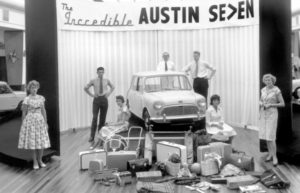
Lots of space inside with minimum dimensions outside, seats for four passengers, impeccable driving characteristics, superior fuel economy, and a very affordable price – precisely this was the brief the creator of the Mini, automotive engineer and designer Alec Issigonis, received from BMC’s Top Management. And the brilliant ideas he implemented in developing this two-door for a family of four had an impact quite sufficient for more than one single car, an impact therefore carried over successfully to other model variants.
Precisely this is why the Mini Van and Mini Estate also appeared on the market in the very first year of production of the classic Mini. And ever since the re-birth of the brand with the market launch of the MINI in 2001, the principle already applied successfully sixty years ago has once again proven its full value: a superior concept is always convincing in many different variants and renditions. Today, this still applies for the small cars MINI 3-door, MINI 5-door and MINI Convertible, for the MINI Clubman and the MINI Countryman in the premium compact segment, and soon for the all-electric powered MINI Cooper SE. They all show their individual strength and unique character, while right inside they are one and the same car in particular: a MINI.
Right from the start the very first sales brochures proudly presenting the Morris Mini-Minor highlighted the car’s clear and steadfast orientation to the future. But to what extent these prophecies would really come true, hardly anybody would have believed back then.
Today, sixty years later, we know that only very few car concepts have survived such a long time, and none of them has ever been converted into such a wide range of variants as the Mini.
One of the reasons for this outstanding success is that from the start the Mini met all the requirements of its time, while offering further qualities in the same process. Measuring just 3.05 metres or 120″ in length and selling at a retail price of £ 496, the Mini was simply perfect for small parking spaces and low budgets. Through its driving qualities and the charming character of its proportions alone, the Mini was however also of great interest to the ambitious motorist seeking not only compact dimensions and superior economy, but also sporting performance particularly in bends as well as individual style on the road.
This blend of different qualities remains as popular today as ever before, with a concept likewise younger than ever. Hence, the current MINI is also more up-to-date and, at the same time, more fascinating and respected than any of its competitors, combining unparalleled efficiency, lasting value of the highest calibre, and incredibly agile handling in the modern mega-city with unrivalled sportiness and design full of expression and quite unmistakable.
Longer, stronger, more sophisticated, more versatile: the first variants of the classic Mini.
Introducing the classic Mini, Alec Issigonis, the creator of this unique car, clearly fulfilled his mission. The Morris Mini-Minor and the Austin Seven, differing solely through their radiator grille, wheel caps and body colour, were both powered by a four-cylinder engine fitted crosswise at the front and delivering maximum output of 34 hp from 848 cubic centimetres.
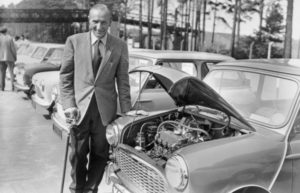
The performance of both models was identical, as was their luggage capacity of 195 litres or 6.83 cubic feet at the rear. Everybody was thrilled by the generous space available, the efficient but powerful engines, the good roadholding and the comfortable suspension this new compact car had to offer. But Issigonis was already looking far into the future – and he was not the only one.
As early as in 1960, BMC added a Mini Van to the classic Mini. Then, proceeding from this van structure with its closed side panels, BMC introduced an Estate version with glass windows all round as well as two rear doors, like the Van.
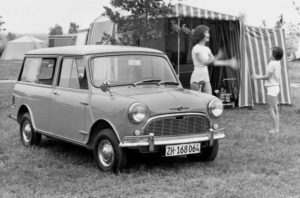
Like the saloons, this body variant was also marketed as the Morris Mini-Traveller and the Austin Seven Countryman with exactly the same technical features. And at the latest in 1961 the potential of the classic Mini really became clear once and for all, the year starting with the introduction of the smallest of all transporters, the Mini Pick-Up. Just half a year later two other Minis, this time at the noble end of the scale, saw the light of day: the Wolseley Hornet and the Riley Elf.
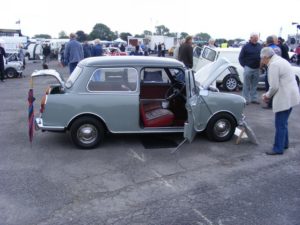
Now, therefore, two further BMC brands were able to benefit from the concept of the classic Mini, both models proudly bearing their own distinguished look through their majestic radiator grilles, an extended luggage compartment and swallow-tail wings at the rear. A very special variant destined more than any other to create the legend of the classic Mini made its appearance in the second half of the year: the Mini Cooper. John Cooper, the famous engineer and manufacturer of sports cars already a close friend of Alec Issigonis, had recognised the sporting potential of this new small car right from the start, when the first prototypes appeared on the track. So he received the go-ahead from BMC’s top managers to develop a small series of 1,000 units of the Mini Cooper featuring a modified power unit enlarged in size to 1.0 litres and offering maximum output of 55 hp.
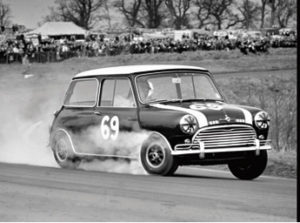
The response to this car entering the market in September 1961 was quite simply euphoric, with only one further request from enthusiasts everywhere: even more power! So Issigonis and Cooper enlarged engine capacity to 1,071 cc, raising engine output to 70 hp.
This made the Mini Cooper S a truly exceptional performer not only on the road, with Finnish driver’s Rauno Aaltonen’s class win in the 1963 Monte Carlo Rally marking the starting point for a truly unparalleled series of outstanding success in motorsport. The highlight, of course, was three overall wins in the Monte Carlo Rally in 1964, 1965, and 1967.
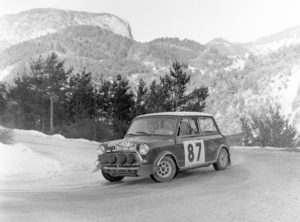
Versatility at its best: from the Mini Moke to the Mini Clubman.
In August 1964 BMC presented yet another version of the classic Mini originally conceived for military use: the Mini Moke, a four-seater open all round and destined to remain in the price list for four years.
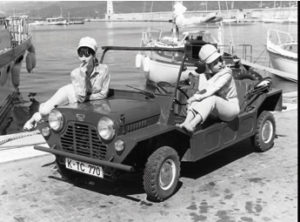
The “bodyshell” of this unique car was made up, for all practical purposes, of the floorpan with wide, box-shaped side-sills, together with the engine compartment and windscreen. To the event of rainfall, a folding soft top appropriately referred to as a “ragtop” at least tried to provide certain protection. Using the drivetrain and technical features of the “regular” Mini, the Mini Moke became a genuine success particularly in sun-drenched parts of the USA and in Australia. By 1967 the time had come for a thorough update of the classic Mini, the car receiving a more powerful engine offering 38 hp from a larger capacity of 998 cc.
Two years later the Mini Clubman joined the range as a slightly larger model with a somewhat different front end compared to the classic Mini. Indeed, this sister car was some 11 cm or 4.33″ longer than the original, the Estate version replacing the Morris Mini-Traveller and the Austin Seven Countryman measuring exactly 3.4 metres or 133.9″ in length, while width, height, and wheelbase remained unchanged. At the same time the Mini Cooper was taken out of production, being replaced by the top model in the Clubman range, the Mini 1275 GT developing 59 hp from its 1.3-litre power unit. A number of other details also changed in 1969, the front sliding windows so typical of the classic Mini since the beginning being replaced on all models by wind-down windows, the door hinges at the outside being moved to the inside, and a special “Mini” badge now standing out proudly on the engine compartment lid.
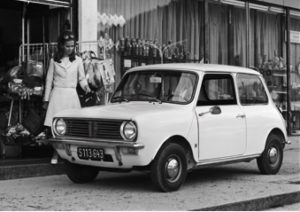
Never-ending classic Mini and the comeback of the Mini Cooper.
Numerous special versions of the classic Mini with all kinds of highlights – from sporting to trendy, from distinguished to fresh – entered the market as of mid-1970. Between 1980 and 1983 the model range was streamlined appropriately, with the Clubman, Estate and Van leaving production. The “only” car left over, therefore, was the classic Mini with its 1.0-litre power unit now delivering 40 hp. And customers, simply loving the car, remained faithful to this little performer for years to come, the five-millionth classic Mini coming off the production line at Plant Longbridge in 1986.
In 1990 fans the world over were delighted to celebrate the comeback of the Mini Cooper once again entering the model range. Now this special model was powered in all cases by a 1.3-litre, production of the 1.0-litre in the Mini ending in 1992 on account of growing requirements in terms of emission management. So from now on all models came with the 1,275-cc power unit and fuel injection.
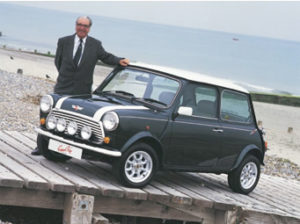
Yet another new variant of the classic Mini made its appearance in 1991 as the last new model in the range. And this was indeed the only Mini to originate not in Britain, but in Germany: Like some tuners before him, a dedicated Mini dealer in the German region of Baden had cut the roof off the classic Mini, turning the car into an extremely attractive Convertible. And contrary to earlier attempts, the result was so good this time in its quality that Rover Group, now responsible for the classic Mini, decided to buy the construction tools and production equipment for the Mini Convertible, which from 1993 to 1996 accounted for sales of approximately 1,000 units.
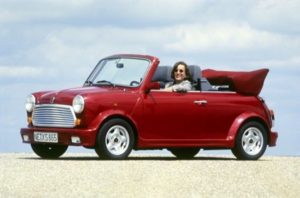
Production of the classic Mini finally ceased once and for all in the year 2000. In the course of time more than 5.3 million units of the world’s most successful compact car had left the production plants in numerous different versions, among them some 600,000 cars built at Plant Oxford between 1959 and 1968. But even after 41 years, there was still a long way to go. For after a break of not quite one year, a new chapter in the history of this world-famous British brand opened up in 2001.
A new start in 2001 – starring the MINI Cooper right from the beginning.
Taking over Rover Group in early 1994, BMW also opened up new perspectives for the Mini brand. The first step was to present a concept version of the MINI Cooper at the 1997 Frankfurt Motor Show offering an outlook at the new interpretation of this unique small car from Great Britain. As a modern rendition of the Mini’s concept so rich in tradition, the new version for the first time combined the classic values of its predecessor with the demands made of a modern car set to enter the 21st century. The series production version of the MINI Cooper made its first official appearance in November 2000 at the Berlin Motor Show, the future-oriented interpretation of the original entering showrooms just a year later in the guise of the 85 kW/115 hp MINI Cooper and the 66 kW/90 hp MINI One. Featuring front-wheel drive, four-cylinder power units fitted crosswise at the front, short body overhangs and ample space for four, the new models successfully took up elementary features of the classic Mini. And while the exterior dimensions of the car were now larger, meeting modern requirements in terms of interior space, the design of the new model clearly retained the proportions so typical of the brand, as well as the unmistakable design icons at the front, the rear and at the side, thus boasting a clearly recognisable link between the MINI and its classical predecessors.

At the same time the MINI built in Oxford stood out clearly as the first premium car in the compact segment, achieving a status strongly reflected by a level of safety uniquely high for a car of this class as well as the uncompromising standard of quality so typical of BMW. The new MINI also set new standards through its surprisingly agile handling, immediately moving right up to the top in terms of driving pleasure. This meant that the new model followed in the footsteps of the classic Mini, but now with a lot more power and performance thanks to the most advanced and sophisticated drivetrain and suspension technology.
Text courtesy of MINI Press